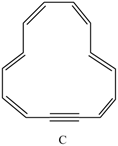
ORGANIC CHEMISTRY W/ALEKS
6th Edition
ISBN: 9781264905430
Author: SMITH
Publisher: MCG CUSTOM
expand_more
expand_more
format_list_bulleted
Concept explainers
Textbook Question
Chapter 15, Problem 35P

a. How many
b. How many
c. Explain why C is aromatic.
Expert Solution & Answer
Trending nowThis is a popular solution!

Students have asked these similar questions
a.How many π electrons does C contain?
b.How many π electrons are delocalized in the ring?
c.Explain why C is aromatic.
6. Consider each compound below. Note the number of T electrons in the ring in each
compound and indicate if it is aromatic or not aromatic (assume planarity for all molecules).
B.
TT electrons
TT electrons
TT electrons
Aromatic?
Aromatic?
Aromatic?
How can you tell a substituent will donate
negative charge into an aromatic ring?
A) There is an oxygen in the substituent
B) There is a lone pair on the atom next to
the ring
C) There is a positive or partial positive
charge on the atom next to the ring
D) There is a nitrogen in the substituent
Chapter 15 Solutions
ORGANIC CHEMISTRY W/ALEKS
Ch. 15.2 - Prob. 1PCh. 15.2 - Problem 17.2 What orbitals are used to form the...Ch. 15.3 - Prob. 4PCh. 15.3 - Problem-17.5 What is the structure of propofol,...Ch. 15.6 - Prob. 7PCh. 15.8 - Prob. 8PCh. 15.8 - Prob. 11PCh. 15.8 - Prob. 12PCh. 15.8 - Problem 17.16 Rank the following compounds in...Ch. 15.8 - Problem 17.17 Draw the seven resonance structures...
Ch. 15 - 17.23 Name each compound and state how many lines...Ch. 15 - Prob. 21PCh. 15 - Prob. 22PCh. 15 - 17.27 Give the IUPAC name for each compounds.
a....Ch. 15 - 17.28 Draw a structure corresponding to each...Ch. 15 - 17.29 a. Draw the 14 constitutional isomers of...Ch. 15 - Prob. 26PCh. 15 - Prob. 27PCh. 15 - 17.38
How many electrons does C contain?
How...Ch. 15 - Prob. 36PCh. 15 - 17.40 Explain the observed rate of reactivity of...Ch. 15 - 17.41 Draw a stepwise mechanism for the following...Ch. 15 - Prob. 39PCh. 15 - 17.43 Draw additional resonance structures for...Ch. 15 - Prob. 41PCh. 15 - Prob. 42PCh. 15 - 17.46 Which compound in each pair is the stronger...Ch. 15 - 17.47 Treatment of indene with forms its...Ch. 15 - Prob. 45PCh. 15 - 17.49 Draw the conjugate bases of pyrrole and...Ch. 15 - 17.50 a. Explain why protonation of pyrrole occurs...Ch. 15 - Prob. 48PCh. 15 - Prob. 49PCh. 15 - 17.53 How many signals does each compound...Ch. 15 - 17.54 Which of the diethylbenzene isomers (ortho,...Ch. 15 - 17.55 Propose a structure consistent with each...Ch. 15 - 17.56 Propose a structure consistent with each...Ch. 15 - 17.57 Thymol (molecular formula ) is the major...Ch. 15 - 17.58 You have a sample of a compound of molecular...Ch. 15 - 17.59 Explain why tetrahydrofuran has a higher...Ch. 15 - 17.60 Rizatriptan (trade name Maxalt) is a...Ch. 15 - 17.61 Zolpidem (trade name Ambien) promotes the...Ch. 15 - 17.62 Answer the following questions about...Ch. 15 - 17.63 Stanozolol is an anabolic steroid that...Ch. 15 - Prob. 61P
Knowledge Booster
Learn more about
Need a deep-dive on the concept behind this application? Look no further. Learn more about this topic, chemistry and related others by exploring similar questions and additional content below.Similar questions
- Using the resonance theory which carbocations is more stable ? And why ?arrow_forwardSerotonin contains an aromatic heterocycle called an indole. a) Fill in the blanks regarding the N atom of the indole. b) Circle the entire aromatic heterocycle and explain what makes it aromatic. НО. serotonin NH₂ hybridization of N: orbital of lone pair:arrow_forward4. Explain why the following molecule is considered aromatic. (it may help to draw a resonance form) O:arrow_forward
- Question 2. Draw the molecular orbital diagrams for the three compounds below. Indicate if they are aromatic, non-aromatic or anti-aromatic using this energy diagram. Justify your answer. Å Å Å Aarrow_forwardClassify each carbocation as primary, secondary, or tertiary. a. b. 人 C. d.arrow_forwardis this molecule aromatic answer by drawing orbitals (VBT), applying huckels law, and drawing frosts circlearrow_forward
- 4. Syn and anti addition can occur with alkenes. 1. Describe syn and anti addition. b. Give an example of syn addition to an alkene and explain why it is syn. c. Give an example of anti addition to an alkene and explain why it is anti. 5. The following reactions shows the dehydration of 2-methylcyclohexanol. Why is 1-methylcyclohexene the major product? X OH H3PO4 84% 16%arrow_forwardDraw a second resonance structure for each carbocation. Then draw the hybrid.arrow_forwardFollowing the instructions for drawing the energy levels of the molecular orbitals for the compounds shown in Figure 8.17, draw the energy levels of the molecular orbitals for the cycloheptatrienyl cation, the cycloheptatrienyl anion, and the cyclopropenyl cation. For each compound, show the distribution of the p electrons. Which of the compounds are aromatic?arrow_forward
- 1. Label the following rings as aromatic, anti-aromatic, or non-aromatic. Briefly indicate your reasoning for any molecules that are not aromatic. 2. label the hybridization at every non-metallic heteroatom. Н BrMg HN H2N. N. 'N' B. `H. Н N'arrow_forwardWhich compound in each set is aromatic? Explain your choice.arrow_forwardExplain why CH3CH,NHCH3 has a higher boiling point than (CH3);N, even though they have the same molecular weight.arrow_forward
arrow_back_ios
SEE MORE QUESTIONS
arrow_forward_ios
Recommended textbooks for you
 Organic Chemistry: A Guided InquiryChemistryISBN:9780618974122Author:Andrei StraumanisPublisher:Cengage Learning
Organic Chemistry: A Guided InquiryChemistryISBN:9780618974122Author:Andrei StraumanisPublisher:Cengage Learning
 World of Chemistry, 3rd editionChemistryISBN:9781133109655Author:Steven S. Zumdahl, Susan L. Zumdahl, Donald J. DeCostePublisher:Brooks / Cole / Cengage Learning
World of Chemistry, 3rd editionChemistryISBN:9781133109655Author:Steven S. Zumdahl, Susan L. Zumdahl, Donald J. DeCostePublisher:Brooks / Cole / Cengage Learning

Organic Chemistry: A Guided Inquiry
Chemistry
ISBN:9780618974122
Author:Andrei Straumanis
Publisher:Cengage Learning


World of Chemistry, 3rd edition
Chemistry
ISBN:9781133109655
Author:Steven S. Zumdahl, Susan L. Zumdahl, Donald J. DeCoste
Publisher:Brooks / Cole / Cengage Learning
Nomenclature: Crash Course Chemistry #44; Author: CrashCourse;https://www.youtube.com/watch?v=U7wavimfNFE;License: Standard YouTube License, CC-BY